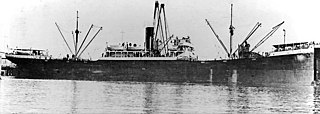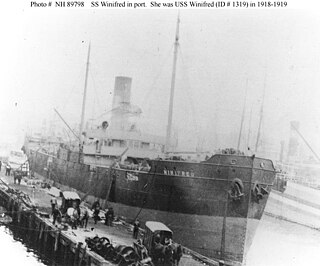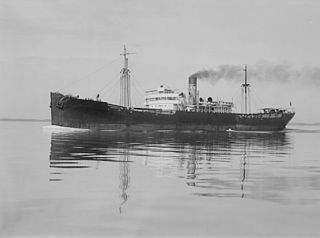
USS Alameda, was a United States Navy tanker in commission from 1919 to 1922. She was built as the civilian tanker SS Alameda, but transferred to the U.S. Navy after completion in 1919. She was sold for commercial service and operated under the names SS Olean and SS Sweep before she was transferred to the Navy again in World War II as USS Silver Cloud (IX-143).

USS Victoria (AO-46) was an oiler for the United States Navy in World War II, and the second ship to bear the name. She was built in 1917 as SS George G. Henry in San Francisco for the Los Angeles Petroleum Company. During World War I, the ship was requisitioned by the U.S. Navy and employed as USS George G. Henry (ID-1560). Between the two world wars and at the beginning of the second, she served as a civilian tanker, initially under American registry, but later under Panamanian registry.

USS Zaca (ID-3792) was a steel-hulled, single-screw freighter that served in the United States Navy from 1918 to 1919. She was the first ship to serve by that name.

USS West Carnifax (ID-3812) was a cargo ship in the United States Navy shortly after World War I. After she was decommissioned from the Navy, the ship was known as SS West Carnifax, SS Exford, and SS Pan Royal in civilian service under American registry.
USS West Coast (ID-3315) was a cargo ship for the United States Navy during World War I. The ship was laid down as SS War Dagger but launched in July 1918 as SS West Coast and reverted to that name at the end of her Navy service.
USS Hisko (ID-1953) was a tanker that served in the United States Navy from 1917 to 1919.

USS Munalbro was a cargo ship that served in the United States Navy from 1918 to 1919.

W. L. Steed was a steam tanker built in 1917–1918 by Bethlehem Shipbuilding Corporation of Quincy for Pan American Petroleum and Transport Company, with intention of transporting oil and petroleum products between Mexican and Gulf ports and the Northeast of the United States. The ship was briefly requisitioned by the US Government during World War I but returned to commercial service in early 1919. The ship was named after William L. Steed, superintendent of the Mexican Petroleum Company of California.

The second USS Wachusett (ID-1840) was a cargo ship that served in the United States Navy from 1918 to 1919.

Wakulla was a steam cargo ship built in 1918-1919 by Los Angeles Shipbuilding & Dry Dock Company of San Pedro for the United States Shipping Board as part of the wartime shipbuilding program of the Emergency Fleet Corporation (EFC) to restore the nation's Merchant Marine.
Wassaic was a steam cargo ship built in 1918-1919 by Los Angeles Shipbuilding & Dry Dock Company of San Pedro for the United States Shipping Board (USSB) as part of the wartime shipbuilding program of the Emergency Fleet Corporation (EFC) to restore the nation's Merchant Marine.

USS Charles (ID-1298) was a troop transport that served in the United States Navy from 1918 to 1920 and was briefly in commission as USS Harvard in 1918 and 1920. She was better known in her role as passenger liner SS Harvard, one of the premier West Coast steamships operated by the Los Angeles Steamship Company.

USS Winifred (ID-1319) was a cargo ship and tanker that served in the United States Navy from 1918 to 1919.

USS Jeannette Skinner (ID-1321), sometimes spelled incorrectly as USS Jeanette Skinner, was a cargo ship that served in the United States Navy from 1918 to 1919.

USS Alaskan (ID-4542) was a United States Navy cargo ship and troop transport in commission from 1918 to 1919.
Sylvan Arrow was a steam tanker built in 1917–1918 by New York Shipbuilding Co. of Camden for Standard Oil Company, with intention of transporting oil and petroleum products between United States and ports in the Far East. The ship was briefly requisitioned by the US Government during World War I but returned to commercial service in early 1919.

USS Standard Arrow (ID-1532) was a United States Navy tanker in commission from 1917 to 1919. She was built as SS Standard Arrow for the Standard Oil Company. In World War II, she was again acquired by the U.S. Navy from Standard Oil and commissioned as USS Signal (IX-142) a station tanker in the Pacific from 1944 to 1946.

SS West Elcajon was a steel-hulled cargo ship built in 1918 for the United States Shipping Board's World War I emergency wartime shipbuilding program.

SS West Hosokie was a steel–hulled cargo ship built in 1918 as part of the World War I emergency wartime shipbuilding program organized by the United States Shipping Board.

USS West Haven (ID-2159) was a steel–hulled freighter that saw service with the U.S. Navy during World War I, and which later saw convoy service during the Battle of the Atlantic in World War II.
















